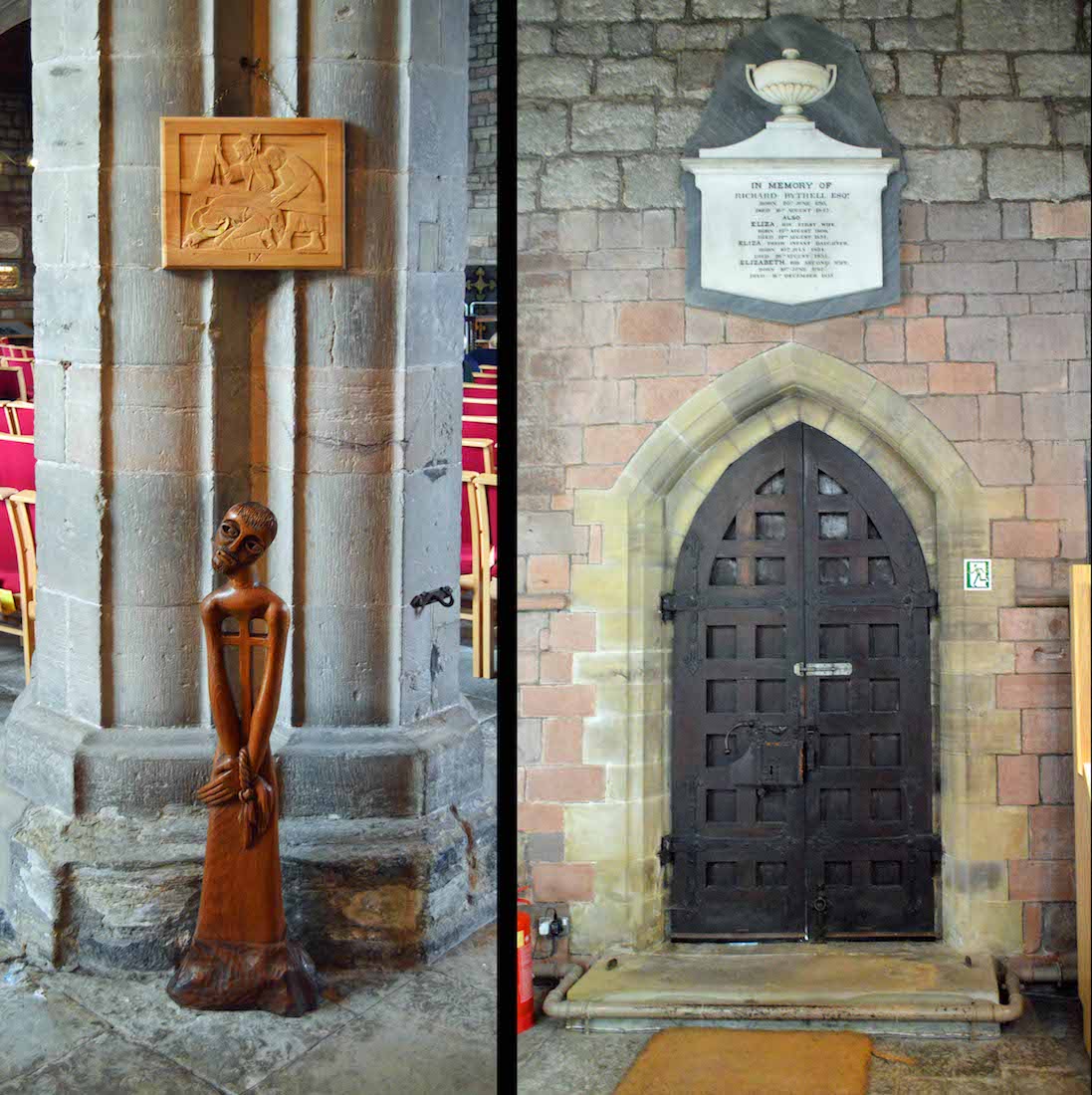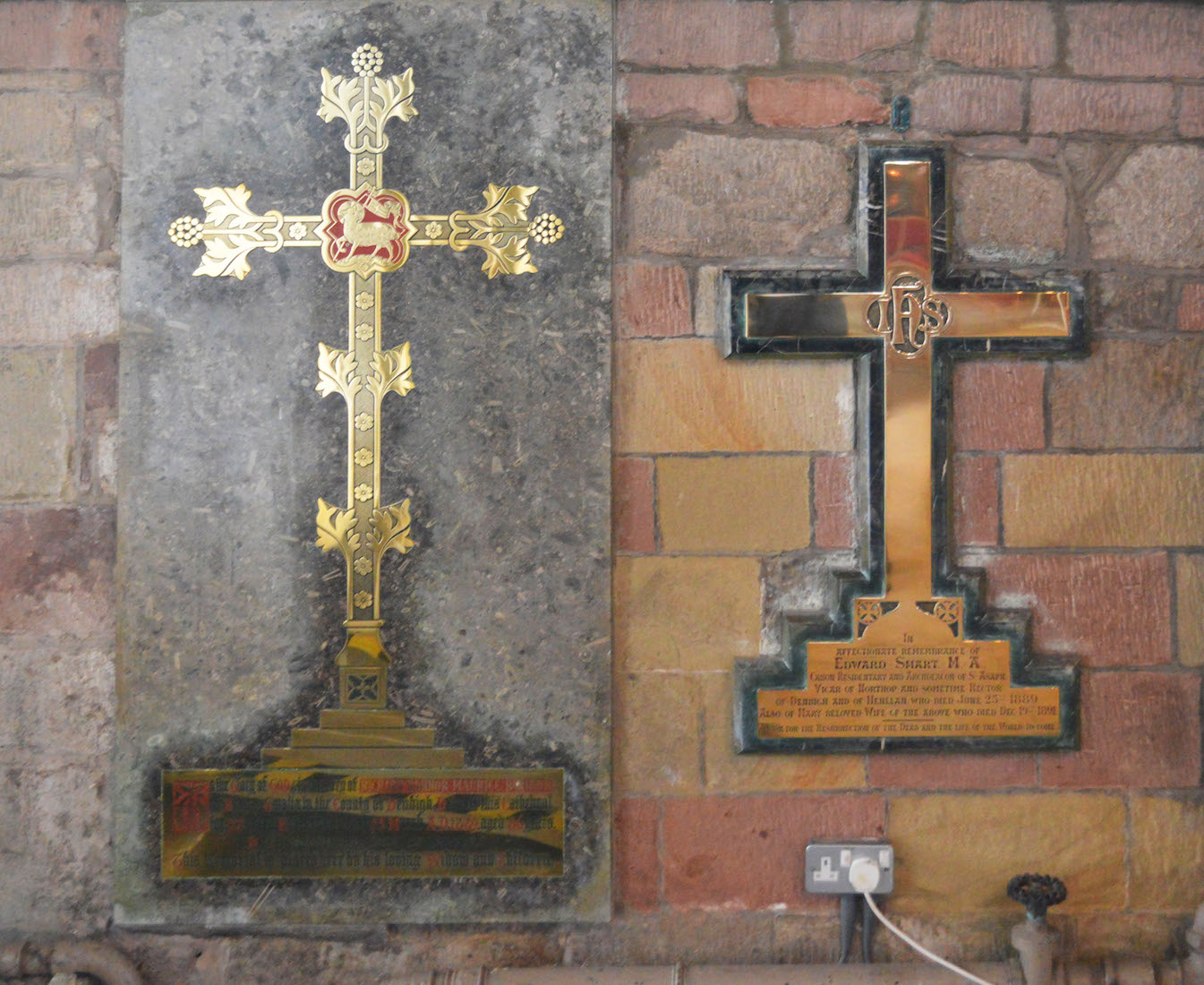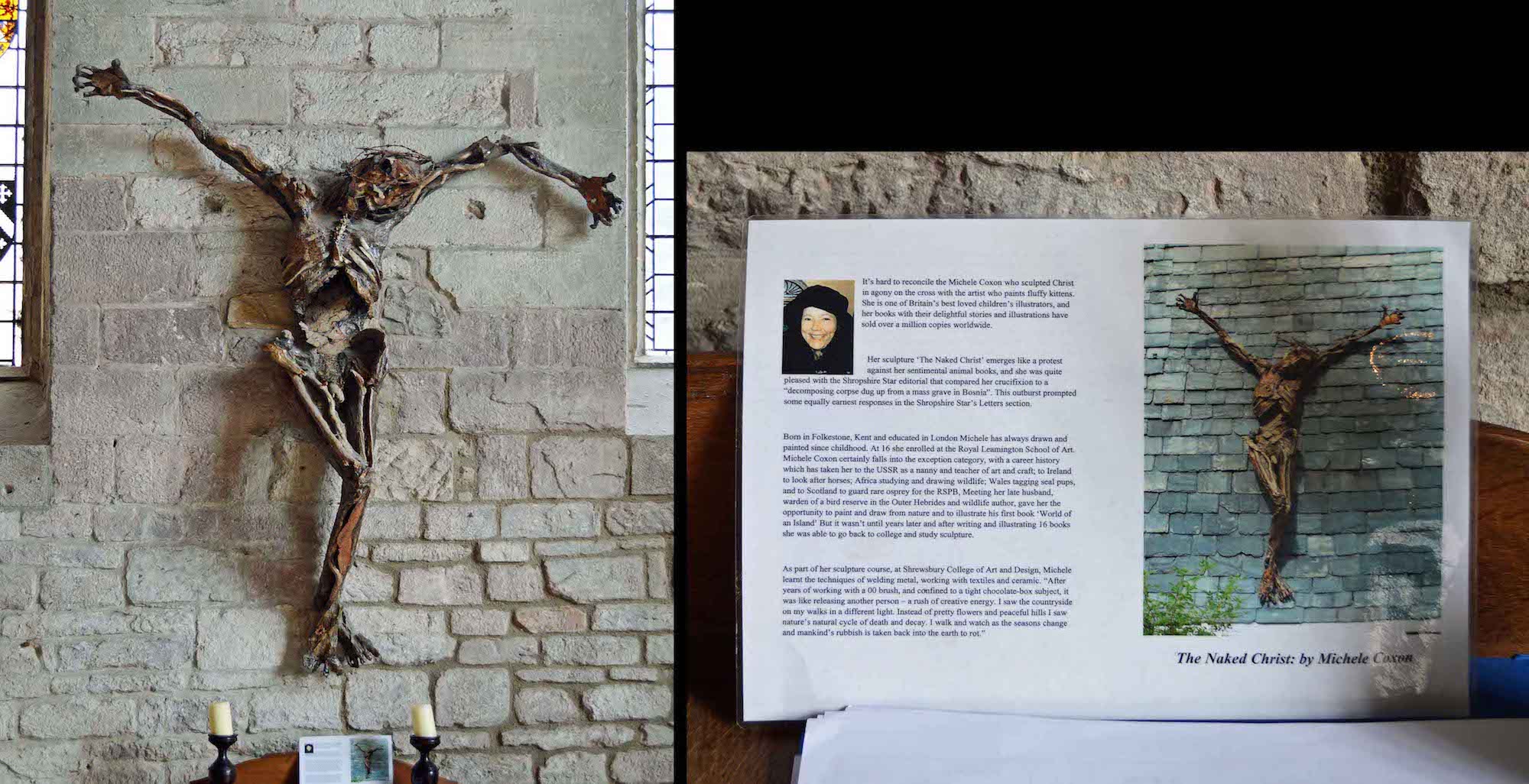
The translation of the Bible into Welsh is obviously a very important part of the history and legacy of the St Asaph Cathedral. As an English speaker, any translation from Hebrew to Welsh seems like a major undertaking! The William Morgan Bible is the greatest treasure in the Cathedral. It is an original printed version published in 1588. PLAN
42. TRANSLATOR INFORMATION

The tribute to the Bible translators continues here – in Welsh and English. “Their work enabled the Welsh people to read the Bible in their own language for the first time.” They were clear forerunners of the British and Foreign Bible Society which only came into existence in 1804.
43. SOUTH NAVE AISLE
Our investigation of the South nave aisle continues. We notice the Station of the Cross at left, and the South nave door at right. The two near windows are of clear glass, but there are interesting looking memorials on the wall between. Below is a slab and an effigy, along with a couple of display tables.
44. STATION OF THE CROSS
At the foot of this column below the Station of the Cross stands a small wooden carving of Christ with bound hands, and a cross and heart image. The door leads outside, past the Southwest graves.
45. WILLIAMS MEMORIAL, SLAB
The Williams memorial commemorates Sir John Williams who died in 1830 and his wife Dame Margaret who died in 1835. It shows two angels in fond embrace, and is known as ‘Angels Rising’. Nothing is known of the origins of the monumental slab below, which carries the image of a hound chasing a hare. Probably of the 14th century, it was found under the floor of the chancel and moved here in 1932.
46. CATHEDRAL MUSIC, ANIAN TOMB
The display table at left tells something of the important past role the Cathedral has had in the promotion and enjoyment of sacred music in North Wales. The table at right tells of the life and times of Bishop Anian II.
47. CAREY MEMORIAL, EFFIGY
The monument is a memorial to William Carey (1769–1846), who was an English churchman and headmaster, Bishop of Exeter and Bishop of St Asaph. The effigy represents Bishop Anian II, who began the rebuilding of the Cathedral after its destruction by the soldiers of King Edward I in 1282.
48. NAVE AISLE
This view from the Eastern end of the South aisle shows a stained glass window and various memorials, a cabinet with five information sheets, and a couple of memorial crosses at bottom left..
49. NAVE WINDOW AND MEMORIALS
This window shows the fearful disciples in their fishing boat, and Jesus walking on the water towards them. The memorials remember various local people.
50. INFORMATION SHEETS
These short and colourful information snippets are set out on top of the cabinet in this aisle. Of particular interest are the notes about the setting up of The (Anglican) Church in Wales.
51. CROSSES
The last items on the South wall of this aisle are these two brass crosses in memory of past members of the Cathedral clergy.
53. NAKED CHRIST
One of the more controversial pieces in the Cathedral is the sculpture of the Naked Christ by Michele Coxon. It aims to depict the horror of the crucifixion rather than the more sanitised images we see in the majority of Churches and Cathedrals today.
The difficult, and most important, question that “The Naked Christ” asks of us is this: how long can we bear to stay in the presence of suffering, especially when we are helpless to do anything about it? Tsunami, earthquake, flood or bomb – we are faced with suffering almost every time we switch the television on or open a newspaper. The only power we seem to have is to switch it off. Faced with our own powerlessness to stop the world’s pain we begin to share something of the deep, agonised love that Mary, Jesus’ mother experienced as she watched her son die.
54. TRANSEPT WALL
At left is the 16th C ‘Spanish Madonna’, set into a niche in the arch leading to the crossing. It is carved from ivory. Tradition has it that it was washed up from the Spanish Armada as they fled the English ships. The window displays ten shields..
55. CUPBOARDS AND LOOKING BACK
The West wall of the transept is taken up with a row of colourful blue storage cupboards!
57. CROSSING VAULTING
The stained wooden vaulting draws our eyes up to the central diamond feature. This has a square trapdoor in the centre: a commonly used device for allowing building materials to be raised up to the higher levels of the tower.
58. CROSSING ANGELS
At each corner of the crossing ceiling there is a colourful angel holding a shield. Each shield bears a religious symbol, including a descending dove, burning coals, and crossed keys.
59. ORGAN DETAIL
Some more details of the organ, continued from #29 … In 1932 Oldrid Scott redesigned the casework and placed it under the north transept arch. Another rebuild took place in 1966 and the organ case was painted in gaudy colours. In 1993 the Dean and Chapter took the decision for a major rebuild in the style of Hill. the firm, Wood of Huddersfield, were chosen to undertake the work to be completed in 1997. David Graebe has designed the casework based on the work of the late Dr Arthur Hill.
60. HOLY FAMILY SCULPTURE
In the centre of the crossing is this very interesting golden sculpture. The artwork, entitled ‘Nativity – This is God: God is Tenderness’ is the work of the local artist and sculptor Fr Rory Geoghegan SJ, a Jesuit priest who lives and works at St Beuno’s Jesuit Spirituality Centre in nearby Tremeirchion.




















